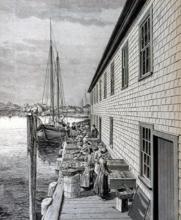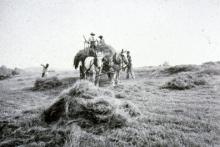Nineteenth Century Industries: Fishing and Agriculture
Fishing
Fishing was one of the original Penobscot industries. From 1850 to 1865, Maine’s codCod Gadus morhua
A food fish of the cool water of the North Atlantic: Gadus morhua. The species that was the major attraction for European fishermen to come to America. The stock is now severely overfished with total collapse and closing of the famous cod fishing grounds off of Newfoundland. and mackerelMackerel
Atlantic mackerel is the species found in the North Atlantic. A schooling, bony, oily, strongly-flavored food fish, green above with dark blue bars and silvery color below. The commercial stock has rebounded since near collapse in the 1970s. Without ice they spoil quickly. They are caught in purse seines which produce relatively little bycatch and no bottom damage. Today most of Maine's mackerel fishery is recreational. fisheries, both onshoreOnshore
In fisheries, fishing conducted less than 3 miles or so from land. The onshore fisheries was characterized by day trips to sea, rather than the longer voyages necessary for the offshore fisheries. and offshoreOffshore
In fisheries, fishing conducted further than 3 miles from land. These generally require larger vessels for overnight passages and work., made up one third to one half of the entire United States catch.
Fishing methods changed after the Civil War. For mackerel, large seine netsSeine
Any long net, having floats at the top edge and weights at the bottom, and hauled by its ends to close around a school of fish. replaced hooks, creating a more expensive but also more productive fishery. For ground fish like cod and haddockHaddock
A North Atlantic food fish related to cod., trawl linesTrawl trawl line
1. A line, sometimes over a mile long, anchored and buoyed, and having hanging from it many closely-spaced lines bearing baited hooks. 2. A great net shaped like a flattened bag for towing on the bottom of the ocean by a boat. were set from doriesDory
Flat-bottomed open rowboat, characteristic of New England, whose planking run fore and aft, the length of the boat, with high sides, a V shaped raked or angled transom, and sharp, graceful sheer.
Read More carried on schoonersSchooner
A sailing vessel of two or more masts, all fore-and-aft rigged. The Thomas W. Lawson, built in 1902, had seven masts. In comparison to a square-rigged vessel of comparable tonnage, a schooner is better for coastwise sailing.. Hundreds of baited hooks were spaced along these thousand-foot lines. In general, Mainers adopted fishery changes more slowly than Massachusetts fishermen, as they required more capital. Mainers gradually left the cod fishery to Massachusetts and focused on sardinesSardines
Small herring, preserved in oil or sauces and canned. Maine had many sardine factories., mackerelMackerel
Atlantic mackerel is the species found in the North Atlantic. A schooling, bony, oily, strongly-flavored food fish, green above with dark blue bars and silvery color below. The commercial stock has rebounded since near collapse in the 1970s. Without ice they spoil quickly. They are caught in purse seines which produce relatively little bycatch and no bottom damage. Today most of Maine's mackerel fishery is recreational., lobsterLobster Homarus americanus
An edible crustacean, Homarus americanus refers to the species found in the North Atlantic., and salmonSalmon
A marine and freshwater food fish, inhabiting North Atlantic waters near the mouths of large rivers. Salmon are anadromous fish, entering rivers to spawn (lay eggs.) In Maine, salmon fishing was once a commercial, then a sport fishery; now wild salmon are an endangered species. Many are farm-raised., which could all be canned.
Agriculture
Belfast was the agricultural center for Waldo County. It exported hay and eggs in the nineteenth century and fertilizer in the early twentieth. In 1887, Belfast shipped 11,000 tons of hay, 11,000 barrels of apples, and 800,000 dozen eggs. Winterport had a strong apple business, and many other towns produced and shipped farm products. After the Civil War, many Maine farmers went west in search of richer soil and a longer growing season.
In the twentieth century, Belfast and Waldo County became the center for poultry raising in Maine. Searsport and Stockton Springs, in the early 20th century, were major shipping ports for Maine potatoes, brought south by the Bangor and Aroostook RailroadBangor and Aroostook Railroad
This rail line was formed in 1891 to combine the lines of the Bangor and Piscataquis Railroad and the Bangor and Katahdin Railroad.
Read More.


